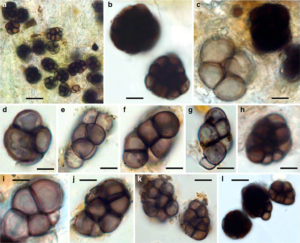Dictyosporella aquatica Abdel-Aziz, in Ariyawansa et al., Fungal Diversity: 10.1007/s13225-015-0346-5, [119] (2015)
Index Fungorum number: IF551481; Facesoffungi number: FoF00974;
Etymology – From the Latin adjective aquaticus, in reference to the freshwater habitat of the fungus.
Holotype – 15-0751
Saprobic on decayed herbaceous stems in freshwater. Sexual morph: Undetermined. Asexual morph: Mycelium 2– 4 μm diam., superficial and immersed in the substrate, yellow-brown to brown. Conidiophores reduced. Conidiogenous cells holoblastic. Conidia 12–22 μm (x = 18 μm, n=55) diam., helicoid when young, quickly becoming masses of cells, brown to black, terminal and lateral, single, determinate. Cells of conidia −13 μm (x = 7.09 μm, n=20) diam., generally increasing in size from basal to apical cells, but with similar colour, globose, subglobose, rounded or with truncate base, brown to dark brown. Number of conidial cells ranging between 4 and 18 (x = 10.3 μm, n=20).
Culture characteristics: Colonies on PDA reaching 20– 25 mm diam. after 15 days at 25 °C, with grey to light brown mycelium, reverse brown, not sporulating in culture.
Material examined – EGYPT, Sohag, River Nile, on submerged decayed stem of Phragmites australis (Poaceae), 14 August 2014, F.A. Abdel-Aziz (CBS H 22127, holotype); Ibid. (MFLU 15-1510, isotype) ex-type living culture, MD1302.
Chaetosphaeriaceae Réblová, M.E. Barr & Samuels
Chaetosphaeria Tul.&C. Tul., Select. fung. carpol. (Paris) 2: 252 (1863)
The genus is a lignicolous perithecial ascomycete with a world-wide distribution. It is characterized by
non-stromatic, dark, papillate ascomata, persistent paraphyses, unitunicate asci with a shallow, refractive Japical annulus and hyaline, ellipsoidal, fusiform to filiform, one to several-septate hyaline ascospores, although several species with versicolorous ascospores are also accommodated in the genus. The systematics of Chaetosphaeria is complicated by the diversity of morphological characters of the asexual morphs. To date around 30 asexually reproducing genera of dematiaceous phialidic hyphomycetes have been experimentally linked with members of the Chaetosphaeriales or their relationship was suggested based on molecular data. The majority of these asexual morphs is linked with Chaetosphaeria, and they represent the greatest variability within the genus.

Fig. 1 Dictyosporella aquatic (holotype). a–l Variously shaped conidia at different stages of maturation. Scale bars: a=20 μm, b–l=10 μm
